Easy Sourdough Flatbread Recipe With Active Starter Or Discard – No Yeast
This post may contain affiliate links. Read disclosure policy.
This delicious and easy sourdough flatbread recipe is the perfect tangy bread made from simple ingredients that can be used as a side or made to be the star of the show. Soft and pillowy sourdough dough is fried until perfection.
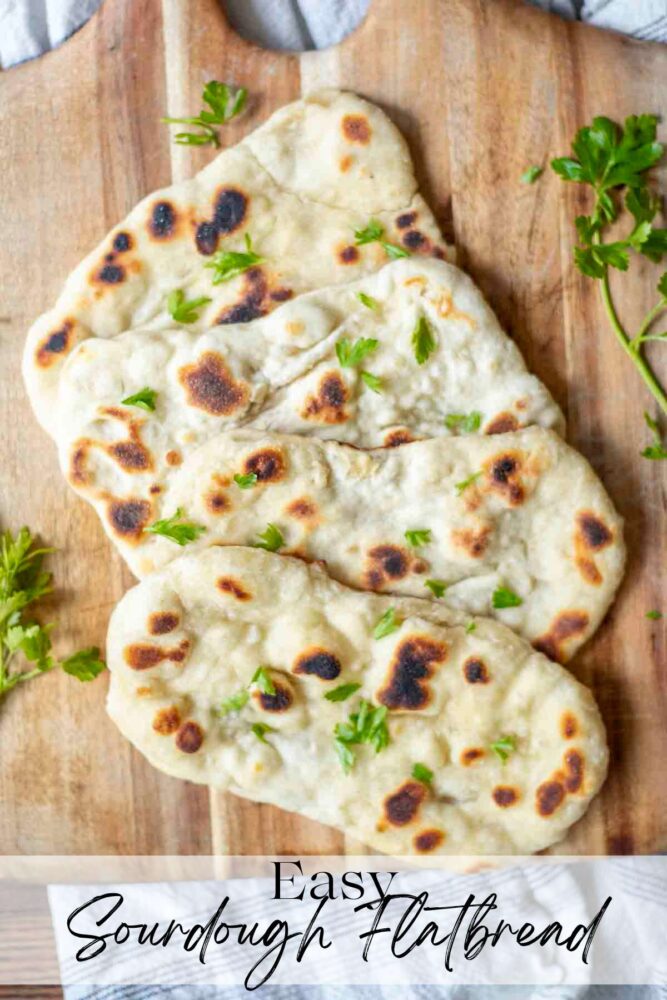
I have a deep love for all things sourdough: from muffins to bread to cookies. If I’m going to make a recipe with regular flour… it is going to be sourdough.
You see, my family struggles with some gut issues. My husband has/had an autoimmune disease (you can see more of that story here) that can be controlled with diet, and my daughter had severe reactions anytime she ate gluten as a toddler. I mean screaming in pain. It was terrible.
After going gluten free for a long time, I did a little experiment incorporating sourdough products. I would follow a recipe, ferment for 8-12 hours and yet still deal with the same issues. So then I tried longer.
The golden ticket was long fermented grains. They had to be fermented for 18-24 hours for us to be able to tolerate them.
Why on earth would we go through so much trouble to be able to tolerate grains? One… budget. Do you know how expensive gluten free flours and products are? Not cheap! And I’m cheap.
But also for flavor and texture that you just can’t get from gluten free grains. Once you switch to fermenting grains you will feel like most other breads are just “blah” in flavor.
These sourdough discard flatbreads are a yummy addition to any dinner. They are like a sourdough naan bread or pita bread you would find at an Indian restaurant but with an extra depth of flavor from the sourdough culture fermenting the dough.
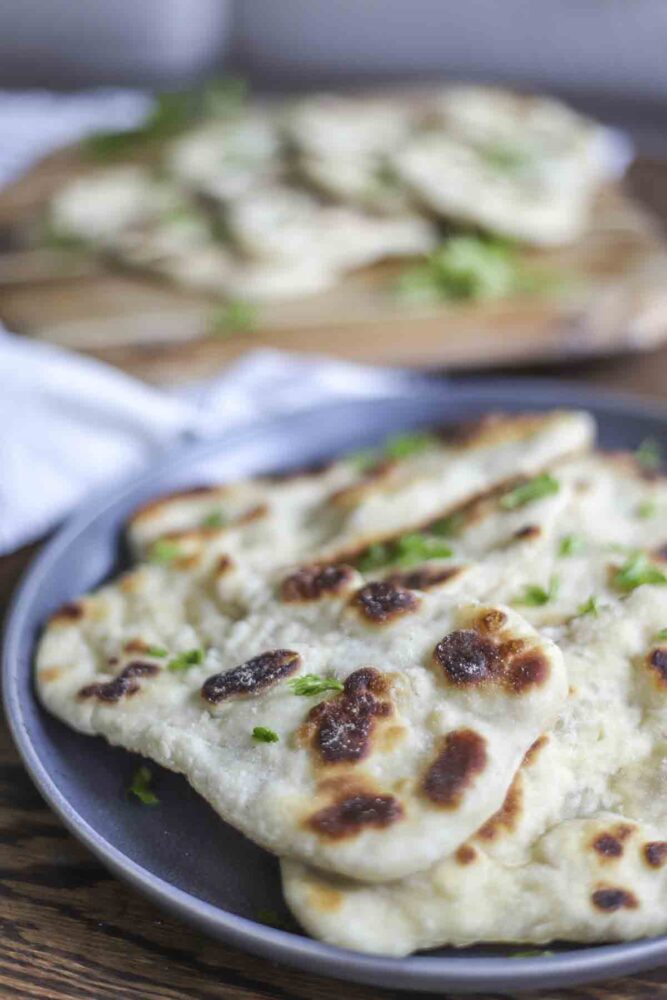
Tips For Making Sourdough Flatbread:
- Using a stand mixer makes this recipe super easy to use. But if you don’t have one, no worries just knead with your hands. It will take a bit longer.
- In our house we can’t eat unfermented glutinous grains without having some tummy issues, so when rolling out the dough, I flour my cutting board with gluten free flour.
- Get multiple skillets going at one time. Rather than sitting there waiting for one or two flatbreads to cook at a time, you can get multiple done making this process way faster.
- If you want to be extra creative, you can press in some chopped fresh herbs to the dough after rolling out.
- And for those who are gluten sensitive (without having an allergy or celiac disease) who may be able to tolerate long fermented sourdough: as a reference, for my family, we like to ferment our grains for 18-24 hours for best tolerability.
Why you will love this recipe:
Super easy recipe. Mix up the dough the night before, ferment, and cook the next day for dinner. It can’t get much easier than that. It only requires a little bit of planning.
Delicious. This recipe is so yummy. Fluffy flatbreads with that delicious fermented tang. Yum.
Won’t heat up your whole house. Ok this may be a personal thing, but for us who don’t have air conditioning in the summer, I hated not being able to eat sourdough bread during the summer because I don’t want to heat up my whole kitchen with the oven.
Healthy. Fermented grains are much healthier and easier to digest compared to unfermented grains. See below for some of the benefits of sourdough.

Benefits Of Sourdough
Sourdough has so many benefits. Not only is it way easier to digest than unfermented grains, especially for those that have trouble digesting grains, but it is also much healthier. This is due to a few different things.
You see, most grains contain an anti-nutrient called phytic acid. Phytic acid binds to the grains and prevents the nutrients from being readily absorbed by our bodies.
When fermentation takes place (like in sourdough recipes), this phytic acid is broken down and the nutrients like folate and B vitamins are better absorbed by the body. Basically, it unlocks the nutrients that are already available in the food for our bodies to use.
It also contains less gluten than non-fermented grains which is also a reason it is easier to digest.
The fiber in sourdough bread and bread products act as a prebiotic. Prebiotic foods feed the good bacteria in your intestines. And here at A Blossoming Life we are all about that gut health. (source).
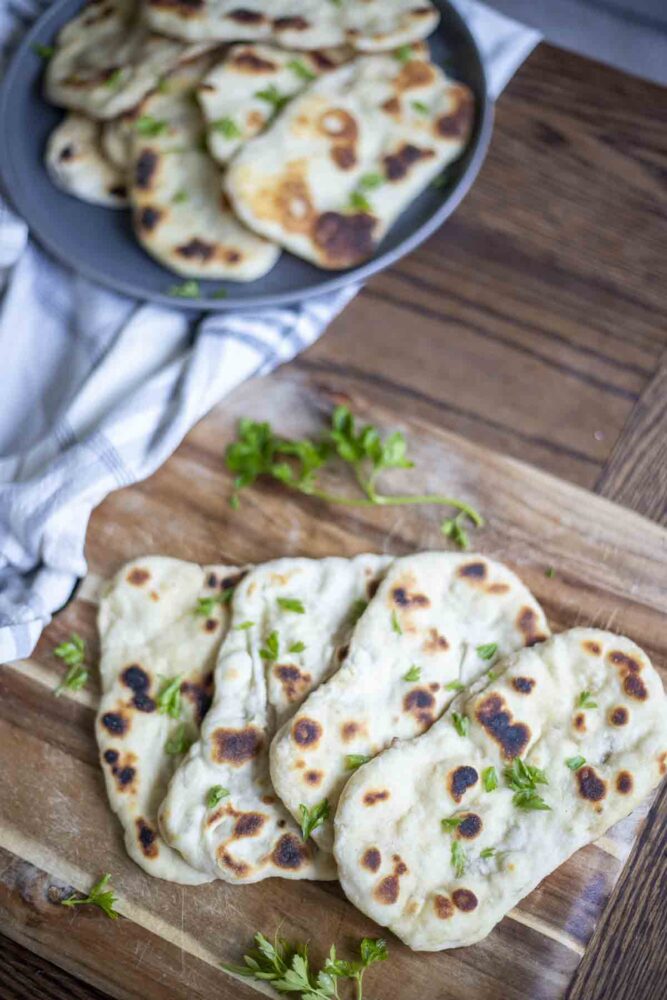
FAQ
It is definitely one of the healthiest bread options. This is because it contains more vitamins and minerals compared to non-fermented grains, contains prebiotics to promote a healthy digestive system, has a higher amount of antioxidants, and has lower gluten quantities making it easier to digest.
Yes, of course. Since sourdough bread contains many health benefits, having a slice of bread is definitely a healthy option for those who can tolerate grains.
Yes. Although I find it does take a little longer for the dough to double in size compared to active sourdough starter. But if you just want a long fermented dough for the health benefits, you can definitely use a starter and allow this to ferment for up to 24 hours.
Sourdough Flatbread Ingredients
All-purpose flour: I prefer organic flour since many times regular wheat is sprayed with pesticides during harvest to help speed the drying time along. You may also be able to substitute up to half of the flour with whole wheat flour. If the dough seems too dry, add a teaspoon or so of water at a time.
Sourdough Starter: Active starter or discard will work. An active starter is one that is nice and bubbly. It should be fed between 4-12 hours before starting the recipe. Or as a great way to use up your discard is by making these into sourdough discard flatbread. This is an unfed sourdough starter that hasn’t been fed in 12+ hours.
Oil: I like to use healthy oils like avocado, olive or melted coconut oils. These are unrefined oils that are non-inflammatory compared to other vegetable oils like canola, corn, vegetable oil etc. You may be able to even use melted butter, although I haven’t personally tried this.
Salt: Is an important ingredient in any recipe as it brings out the flavor.
Water: With sourdough recipes, it is best to use filtered room temperature or slightly warm water if you can, since the chlorine in the water can kill or inhibit the yeast growth.
Tools you may need:
Stand mixer (optional)
Measuring cups and spoons
Kitchen scale (if you would prefer to measure this way)
Rolling pin (optional)
Cast iron skillet (optional)
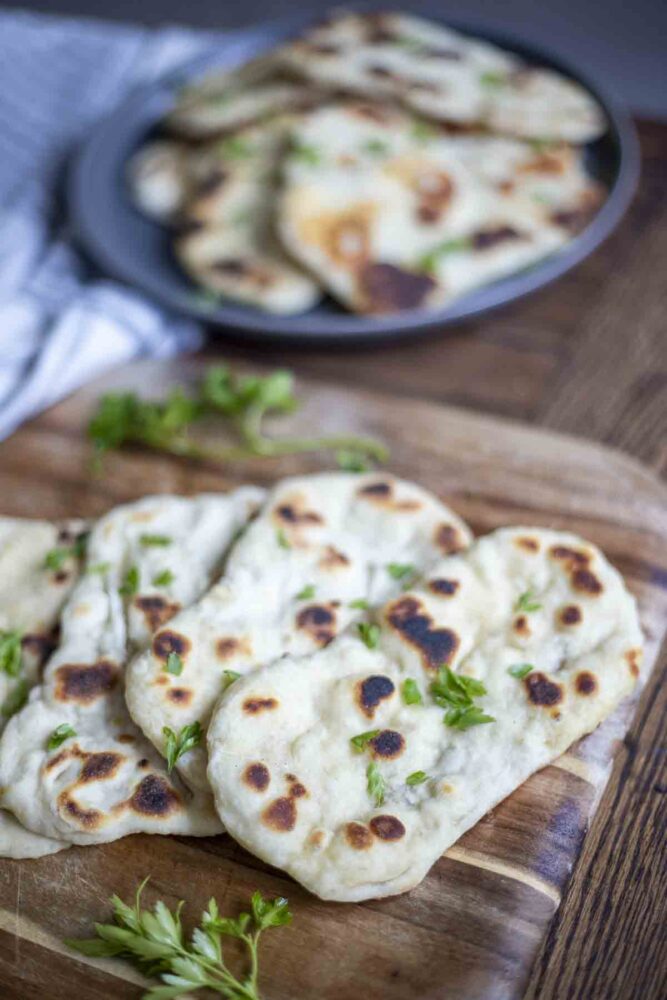
How To Make Sourdough Flatbread:
Create The Dough
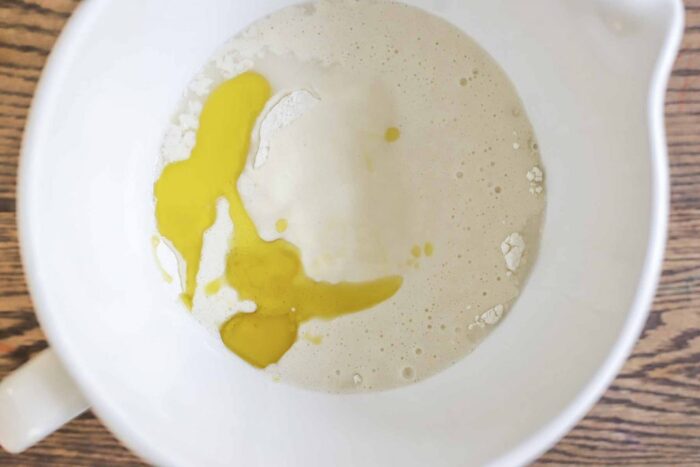
In a stand mixer with a dough hook or large bowl, add flour, sourdough starter, water, oil and salt.
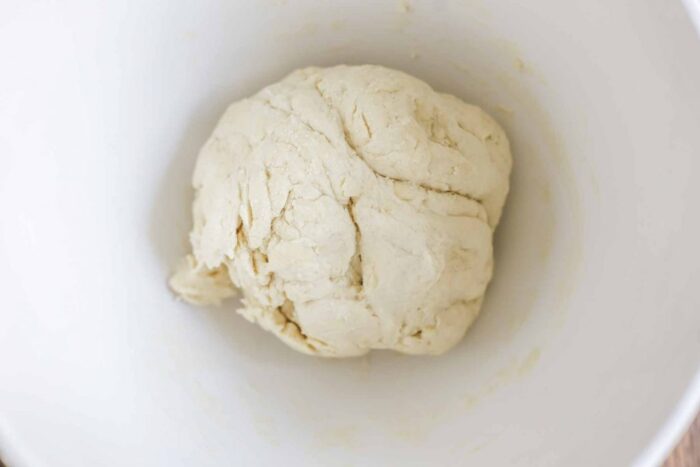
Knead for about 10 minutes until the dough is nice and stretchy (It should pass the windowpane test. This is where you stretch a piece of dough into a square with your fingers. If you can stretch it enough to see through without breaking, it is ready to go). You can also knead by hand, but this takes a little bit longer.
If the dough seems a bit too wet, you can add a tablespoon of flour at a time. If it seems to dry, add a teaspoon of water at a time until it just comes together.
Put dough into a lightly greased bowl and cover with a tight fitting lid, plastic wrap, damp towel, or beeswax wraps.
Place in a warm place for 8-24 hours and allow to rest. The longer the fermentation the more of the gluten that breaks down and the easier to digest. The dough should double in size.
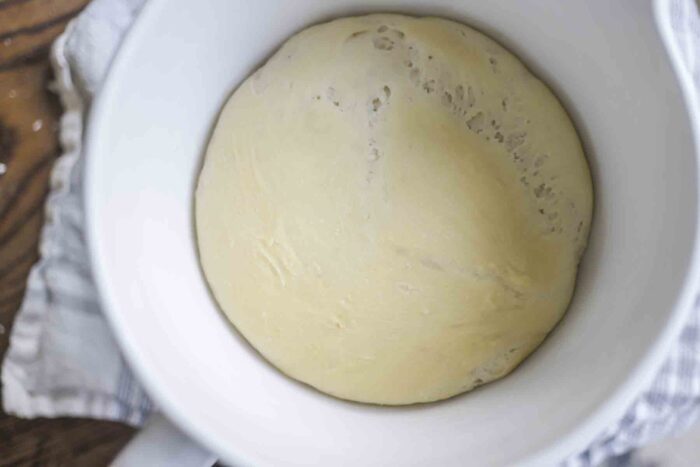
The Next Day: Roll Out And Cook
Preheat skillets to medium heat. I like to get multiple skillets going at one time so that way it takes less time to cook and I’m not sitting there forever flipping flatbread. I also like to do this tactic with pancakes.
Remove the dough from the bowl.
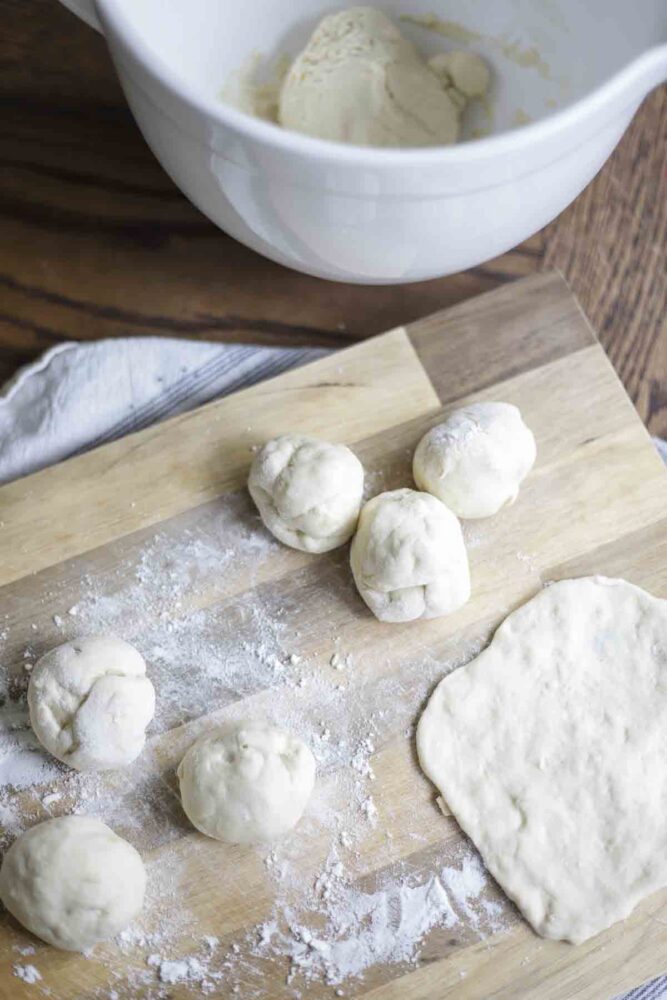
Divide the dough into 10-12 even sized dough balls. I like to do this by splitting the dough in two equal pieces, then halving each half into another half and continuing this until the desired amount of flatbread dough is created.
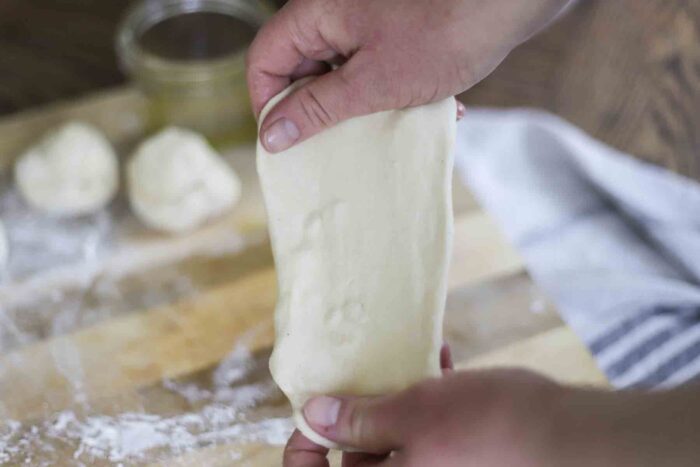
Roll out each individual ball into a circle or rectangle about 1/4-1/2 inches thick on a clean work surface. You can use a rolling pin or just press out with your hands and then stretch the dough carefully into the desired size and shape. Trying not to overstretch and tear the dough. No need to create the perfect circle.
*If digesting unfermented flour is not good for you, there are a few ways to roll the dough out without having to worry about this part of the recipe. If you have a solid surface countertop this is easy to do without flour. Simply roll out on a clean counter and use a little oil if needed. You can also use gluten free flour to roll out dough. This is what I do.
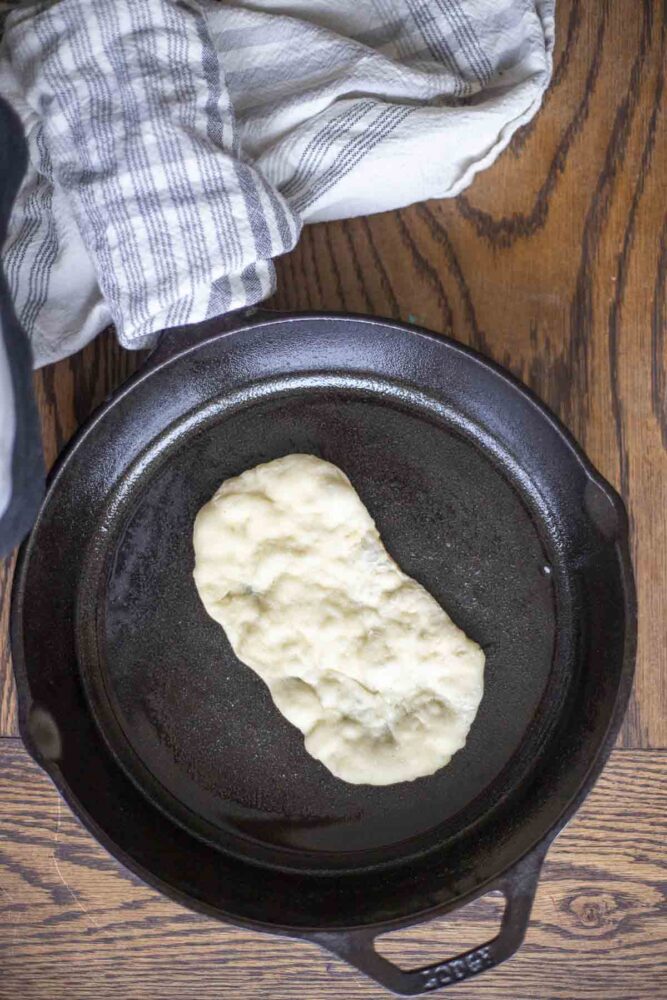
Brush flatbreads with a little oil and place into a lightly oiled hot skillet.
Allow to cook for about 3-4 minutes on the first side flip and finish cooking for about 4 minutes on the second side. The dough will get bubbly and should char a bit.
Place on a plate and serve.

Bakers Schedule: For Dinner
8 AM: The morning before wanting to make this recipe, feed your sourdough starter. If you want to use sourdough discard, you can skip this step.
4-6 PM: Create your dough. Add to a lightly oiled bowl and cover with a tight lid or plastic wrap. Place at room temperature.
5 PM The Next Day: Roll out dough and cook.
Storage:
Store in an airtight container at room temperature for up to 4 days.
Freezing sourdough flatbread:
I love to make double and triple batches of this recipe and then freeze them for a quick meal. Once the flat bread has cooled, just place them in a gallon sized freezer bag and freeze for up to 3 months. They naturally don’t stick together.
What can I do with flat sourdough bread?
- Serve it as a side
- Pizza dough- Add your typical ingredients or make a delicious white bean pizza by blending up white beans with a little garlic, olive oil, and Italian seasonings. Spread on the sourdough naan, sprinkle with cheese, and bake at 400 for about 10 minutes or until the cheese is bubbly.
- Sandwiches – We love turning this into sandwich “bread”, grilled cheese, PB & J’s, breakfast sandwiches with eggs and sausage. You name it.
- Avocado “toast”
- Taco shells for taco night
- Top with a little olive oil, tomatoes, basil and fresh mozzarella for a Caprese style.
- Sprinkle with everything but the bagel seasoning, sesame seeds, fresh herbs like parsley or rosemary.
- Brush with butter and add some cinnamon and brown sugar for an easy dessert the whole family will love.
Find More Sourdough Recipes
- Oatmeal Breakfast Cookies
- Apple Scones With Cinnamon Glaze
- Discard Chocolate Chip Bread
- Quick Sourdough Discard Pancakes
- Sourdough Discard Crackers
If you’ve tried and loved this recipe, make sure to come back and give it 5 stars and tag me on Instagram @ablossominglife.
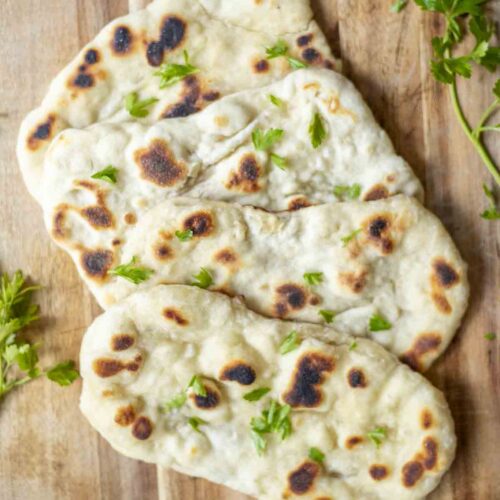
Sourdough Flatbread
Ingredients
- 3 cups all-purpose flour 440g
- 1 cup sourdough starter active or discard will work (240g discard)
- 1/2 cup water 125 g
- 2 tbs oil olive or avocado preferably.
- 1/2 tsp salt
- Oil for cooking
Instructions
- In a stand mixer with a dough hook or large bowl, add flour, sourdough starter, water, oil and salt.
- Knead for about 10 minutes until the dough is nice and stretchy.
- Put dough into a lightly oiled bowl and cover with a tight fitting lid, plastic wrap, or beeswax wraps.
- Place in a warm spot for 8-24 hours.
- The Next Day: preheat skillets to medium heat.
- Remove the dough from the bowl and divide the dough into 10-12 even sized balls.
- Roll out or pat and stretch each individual ball into a rectangle about 1/4-1/2″ thick.
- Brush flatbreads with a little oil and place into a lightly oiled skillet.
- Allow to cook for about 3-4 minutes on each side. The dough will get bubbly and should char a bit.
- Place on a plate and serve.

